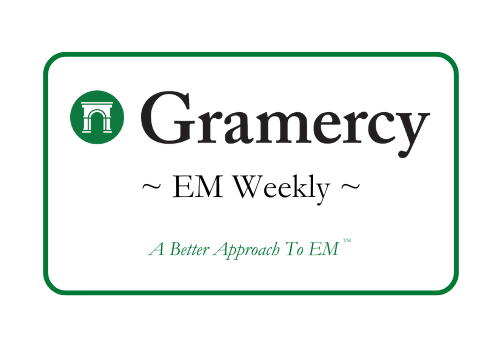Contents
Market Overview
Macro Update
Investors this week continued to focus on tariffs, stubborn inflation and possible negotiations to end the conflict in Ukraine.
The U.S. on Monday announced it would impose 25% tariffs on all imports of steel and aluminium, which would go into effect March 12th. This was followed by President Trump’s memorandum instructing U.S. agencies to analyze impairments to U.S. market access globally, in preparation for reciprocal tariffs on a country-by-country basis starting April 1st. Investors saw the delayed implementation of the reciprocal tariffs as a win, and the market reaction was muted.
On U.S. inflation, Wednesday’s CPI release showed a substantial 0.5% month-over-month increase, the highest monthly reading since August 2023. That was compounded by an increase of 3.3% year-over-year in core CPI, above the consensus of 3.1%. As a result, the 10-year U.S. Treasury note jumped 11bps to reach 4.65%. On Thursday, PPI data for January showed a 0.4% month-over-month increase, versus an expected increase of 0.3%. Nonetheless, following market analysis of the components, Treasuries were set to end the week largely unchanged at 4.65%. Investors noted that the categories that feed into the Fed’s preferred inflation gauge (the PCE index) had actually declined. Friday’s retail sales were also considerably weaker than expected.
In his testimony to Congress, Fed Chair Jerome Powell made it clear that while “we don’t get excited about one or two bad [CPI] readings”, the Fed wants “to keep policy restrictive for now”. Markets are currently pricing in around 40bps of rate cuts from the Fed, 80bps cuts from the ECB and 60bps cuts from the BoE until the end of year.
In the geopolitical sphere, a one-and-a-half hour telephone conversation between President Trump and Russian President Putin led to preparations towards negotiations aiming to end the Ukraine war. This weekend, the Middle East will remain in focus, with Hamas confirming it would free more hostages in line with the ceasefire agreement with Israel. Qatari and Egyptian mediators have been working around the clock to ensure that the agreement remains in place.
The S&P 500 was on track to end the week up by almost 4.0% and the U.S. dollar continued to weaken, with the DXY ending the week at 106.7 from 108.3. Oil prices were unchanged following their move higher mid-week.
EM Credit Update
Despite a turbulent week with volatile U.S. Treasury yields, emerging market sovereign credit cash bonds delivered only small negative returns, ending the week to Thursday down 0.24%. Investment grade bonds (-0.32%) underperformed high yield bonds (-0.14%) on the back of a longer duration profile (7.5 years vs. 5.5 years). Spreads were marginally tighter at -2bps with investment grade and high yield performing in line.
Emerging markets corporate credit bonds delivered a total return of +0.06% in the week to Thursday, with investment grade bonds (-0.05%) underperforming high yield bonds (0.20%,) again on the back of a longer duration profile (4.8 years vs. 3.6 years). Z-spreads ended the week tighter in both investment grade bonds (-7bps) and high yield bonds (-13bps).
EM local currency bonds ended the week to Thursday up 0.07%, with carry and FX moves offsetting negative price action following Wednesday’s U.S. CPI release.
Lebanese USD bonds were the big outperformer in the week to Thursday, boosted by the appointment of well-regarded economy and finance ministers. Ukrainian USD bonds also performed well on the back of plans for peace talks announced by President Trump.
Ecuador’s USD bonds were the clear underperformer of the week following the closer-than-expected results in the first round of the Presidential Elections, which have threatened victory for incumbent President Noboa. Markets fear a potential turnaround in fiscal and debt policy if the opposition candidate Luisa Gonzalez wins the April 13th run-off.
On the new issue front, it was a very quiet week for sovereigns, with only Albania and Israel coming to the public bond market. Corporate issuance also slowed with only five deals pricing across three regions.
The Week Ahead
There is a U.S. holiday on Monday for Presidents’ Day. On Tuesday, the U.K. releases unemployment figures, Canada releases CPI data and Japan reports its trade balance. Tuesday’s U.S. Empire State Manufacturing survey will also be watched for any pick-up in activity after the bad weather in January.
Next week also sees U.S. housing data, the Philadelphia Fed Business Outlook and leading indicators, U.K. and Japan CPI, as well as a flurry of flash PMIs out of India, Japan, the Eurozone, the U.S. and the U.K.
On Friday, the University of Michigan will release the final results of its consumer sentiment index. Markets will watch for confirmation of the jump in 12-month-ahead consumer inflation expectations to 4.3%.
Central bank rate meetings include Australia, New Zealand, Indonesia and Egypt. Markets will also be focused on the Fed’s latest minutes and speeches by the presidents of the San Francisco and Chicago Feds.
Germany’s federal elections take place on Sunday, February 23rd.
Fixed Income
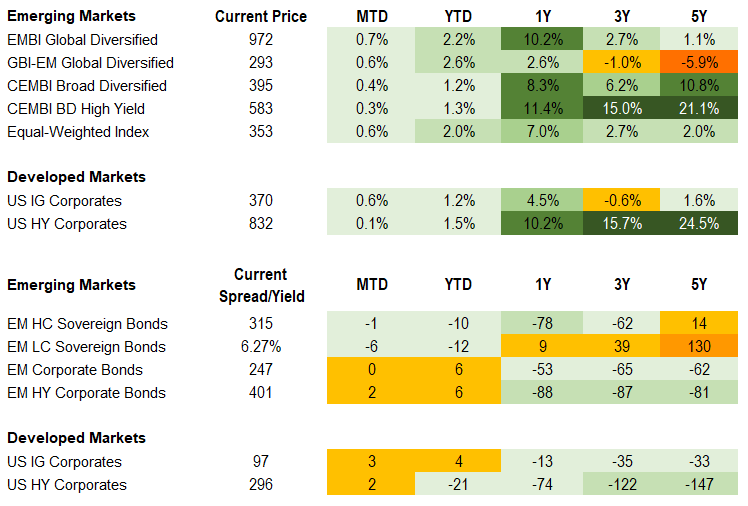
Equities
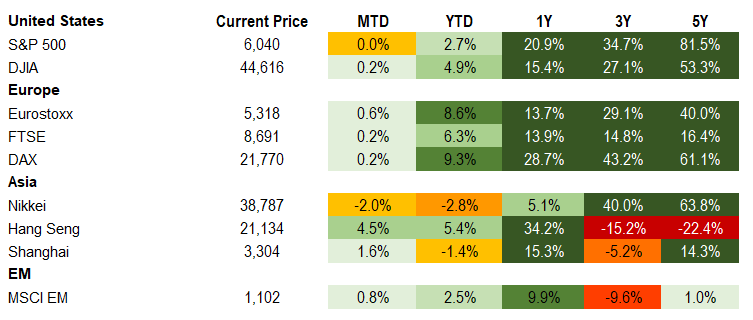
Commodities

Source for data tables: Bloomberg, JPMorgan, Gramercy. EM Fixed Income is represented by the following JPMorgan Indicies: EMBI Global, GBI-EM Global Diversified, CEMBI Broad Diversified and CEMBI Broad High Yield. DM Fixed Income is represented by the JPMorgan JULI Total Return Index and Domestic High Yield Index. Fixed Income, Equity and Commodity data is as of February 14, 2025 (mid-day).
Country Highlights
Trump-Putin Reset Means Far-Reaching Implications for Ukraine and Markets
Event: President Donald Trump and his Russian counterpart Vladimir Putin had a long phone conversation on global issues, including Ukraine, and decided to have their respective teams start negotiations “immediately” to end the war, according to a social media post by President Trump. They also “agreed to work together, very closely, including visiting each other’s Nations”, Trump wrote.
Gramercy Comment: This is the first formal communication between a U.S. and a Russian president since Russia’s invasion of Ukraine three years ago. It is a development that overnight turned President Putin from a pariah in the Western world into an invitee to the White House and is likely to have material implications across markets and asset classes. On the positive side, the apparent reset in U.S.-Russia relations at the highest level, and potential negotiations over Ukraine, should support investor sentiment on emerging markets against other headwinds and help lower global energy prices and inflation pressures in the near term. It is also likely to extend the rally in Ukraine’s sovereign bonds in the near-term.
On the other hand, we think a bilateral “peace deal process” driven by Washington and Moscow and potentially sidelining Kyiv and Brussels is an uncomfortable geopolitical situation for Europe and Ukraine. This brings us to the downside: We are of the view that any potential “deal” that could be acceptable to Russia in the current geopolitical context, especially given a Russia-friendly White House, is likely to heavily favor Moscow’s objectives on Ukraine. This would be an outcome that is inconsistent with Ukraine’s pro-Western strategic orientation and constructive medium-term outlook on its economy. This is a risk we feel markets are currently ignoring.
Venezuela Resumes Deportation Flights, Meeting Key Trump Demand
Event: This week Venezuela accepted the first two repatriation flights from the U.S., following the Trump Administration’s “Special Missions Envoy” Richard Grenell’s recent visit to Caracas to meet with Nicolas Maduro, Venezuela’s de-facto President.
Gramercy Comment: From a market perspective, this is a credit-positive development. As we wrote in our analysis last week, the Grenell-Maduro meeting in Caracas was a clear signal that despite hawkish rhetoric, the direction of travel in U.S. policy on Venezuela at the start of the Trump 2.0 Administration seems to be towards pragmatism and away from the failed “maximum pressure” approach under Trump 1.0. Tangible developments, such as last week’s release of U.S. prisoners held by Venezuela, and now the resumption of deportation flights endorsed by Maduro, are likely to support the pragmatic approach, which appears to be achieving White House objectives.
This is favorable for the continuation of OFAC licenses for U.S. oil companies operating in Venezuela, the key near-term signpost on where the bilateral relationship is headed. The direct communication channel between Washington and Caracas that seems to have been re-established could eventually facilitate more meaningful negotiations on a future domestic political arrangement. It could also pave the way for the re-establishment of diplomatic relations, which could ultimately lead to a sovereign debt restructuring and IMF involvement. The next round of developments could come in April, when regional and legislative elections have the potential to provide an opening for political dealmaking between at least a subset of the opposition and the Maduro regime, especially if the carrot of U.S. sanctions relief remains credible.
Tighter-Than-Expected Presidential Election in Ecuador Brings Uncertainty
Event: Ecuador’s Presidential Elections last Sunday produced a razor thin margin between incumbent, market-friendly President Daniel Noboa, and populist challenger Luisa Gonzalez, who is a proxy for former exiled President Rafael Correa. With 99.5% of votes counted at the time of writing, the two candidates will participate in a run-off election on April 13th. They were separated by less than 17,000 votes in favor of Mr. Noboa, (44.16% vs. 44.0% for Ms. Gonzalez), setting up what promises to be an extraordinarily competitive second round.
Gramercy Comment: Markets had priced in the expectation of at least a comfortable lead for Noboa, if not an outright win in the first round, and were disappointed by the competitiveness of the race. Ecuador’s sovereign bonds, one of the top EM performers in 2024 and this year thanks to Noboa’s market-friendly approach and cooperation with the IMF, gave back almost all their YTD gains. Markets are hopeful that President Noboa will be able to leverage his incumbency advantage, and potential mistakes by the Correista camp, over the next two months to clinch a victory in April. We believe a Noboa victory would ensure economic policy continuation and productive relations with the IMF and the Trump Administration. However, the specter of a return to President Correa’s brand of leftist populism will keep investors cautious ahead of the run-off.
Meanwhile, the legislative elections resulted in a material structural change to Ecuador’s domestic political environment. The ADN party of President Noboa and the RC party of Gonzalez won almost identical shares of the 151-seat National Assembly. This is a stark contrast to the traditionally highly fragmented and dysfunctional parliaments of the past. We see this as favorable for political stability and governability and believe it would enhance the credit-positive implications in the event President Noboa prevails in the second round (our base case). It could also limit the credit-negative implications in the case of a Gonzalez victory.
Emerging Markets Technicals


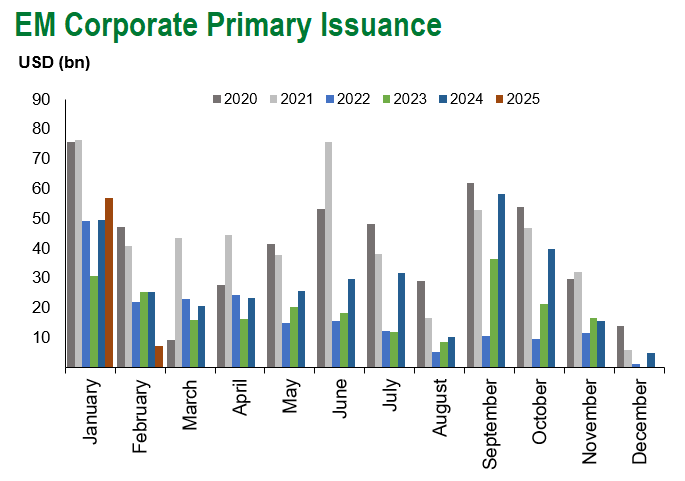
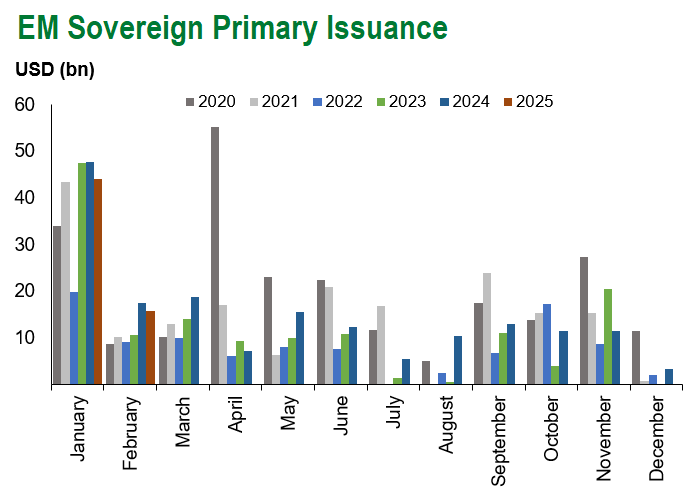
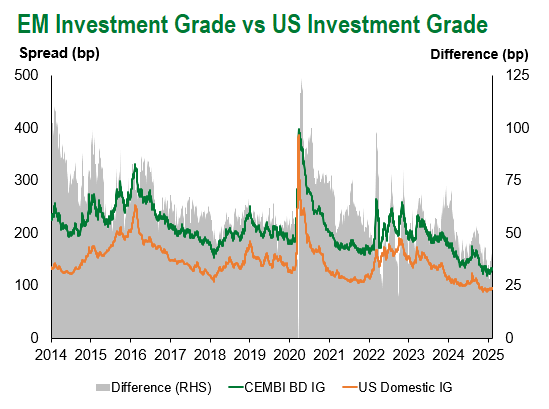
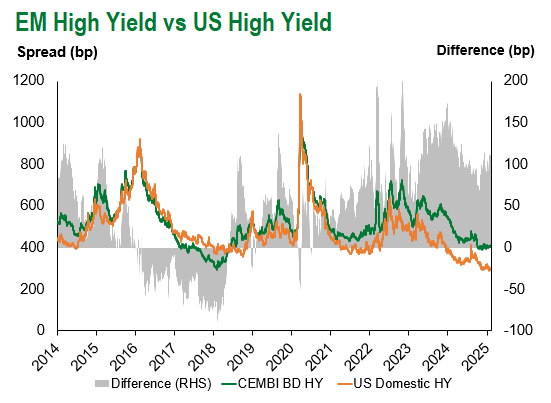
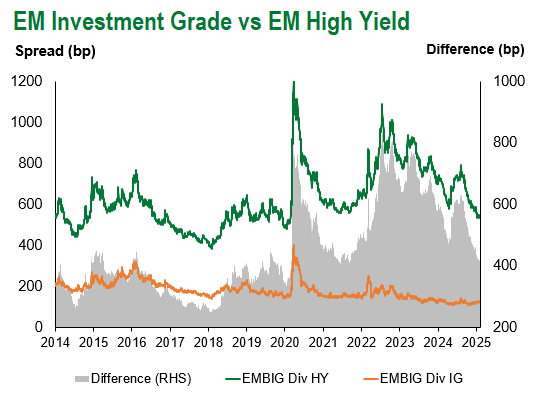
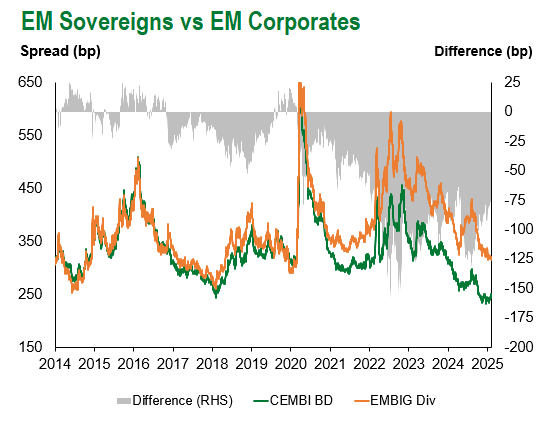
Emerging Markets Flows
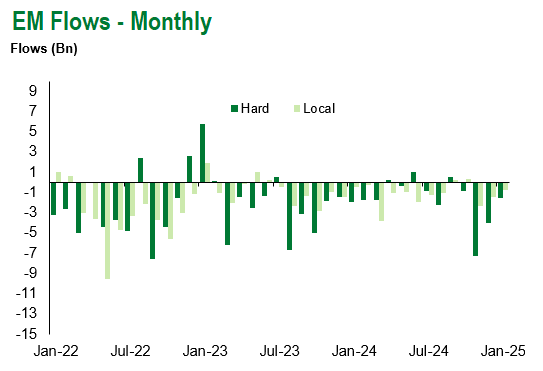
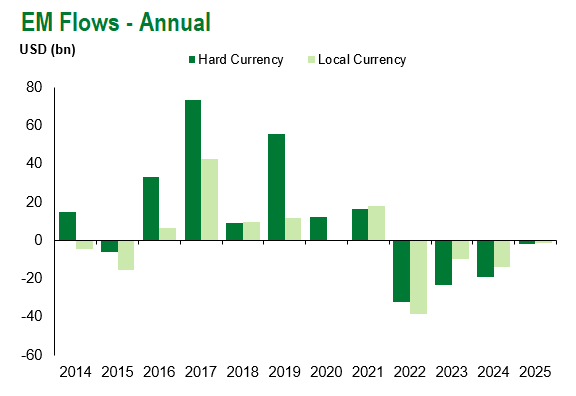
Source for graphs: Bloomberg, JPMorgan, Gramercy. As of February 14, 2025.
For questions, please contact:
Simon Quijano-Evans, Managing Director, Chief Strategist, [email protected]
Kathryn Exum, CFA ESG, Director, Co-Head of Sovereign Research, [email protected]
Petar Atanasov, Director, Co-Head of Sovereign Research, [email protected]
This document is for informational purposes only. The information presented is not intended to be relied upon as a forecast, research or investment advice, and is not a recommendation, offer or solicitation to buy or sell any securities or to adopt any investment strategy. Gramercy may have current investment positions in the securities or sovereigns mentioned above. The information and opinions contained in this paper are as of the date of initial publication, derived from proprietary and nonproprietary sources deemed by Gramercy to be reliable, are not necessarily all-inclusive and are not guaranteed as to accuracy. This paper may contain “forward-looking” information that is not purely historical in nature. Such information may include, among other things, projections and forecasts. There is no guarantee that any forecasts made will come to pass. Reliance upon information in this paper is at the sole discretion of the reader. You should not rely on this presentation as the basis upon which to make an investment decision. Investment involves risk. There can be no assurance that investment objectives will be achieved. Investors must be prepared to bear the risk of a total loss of their investment. These risks are often heightened for investments in emerging/developing markets or smaller capital markets. International investing involves risks, including risks related to foreign currency, limited liquidity, less government regulation, and the possibility of substantial volatility due to adverse political, economic or other developments. References to any indices are for informational and general comparative purposes only. The performance data of various indices mentioned in this update are updated and released on a periodic basis before finalization. The performance data of various indices presented herein was current as of the date of the presentation. Please refer to data returns of the separate indices if you desire additional or updated information. Indices are unmanaged, and their performance results do not reflect the impact of fees, expenses, or taxes that may be incurred through an investment with Gramercy. Returns for indices assume dividend reinvestment. An investment cannot be made directly in an index. Accordingly, comparing results shown to those of such indices may be of limited use. The information provided herein is neither tax nor legal advice. Investors should speak to their tax professional for specific information regarding their tax situation.
